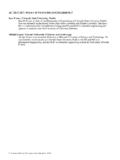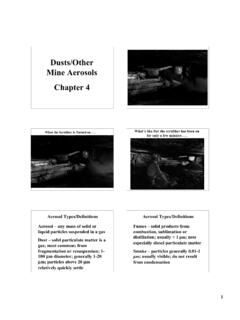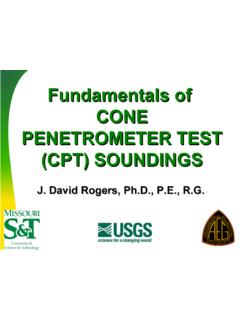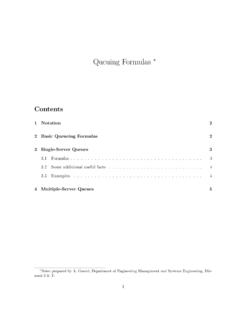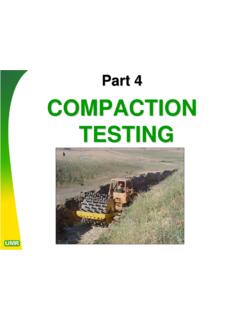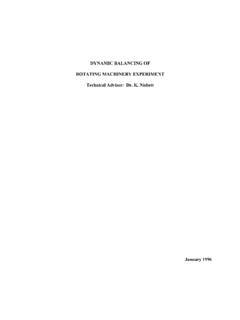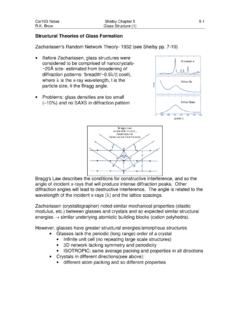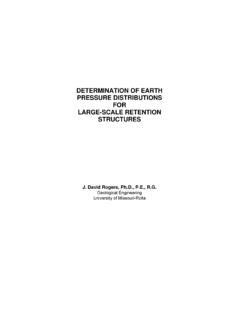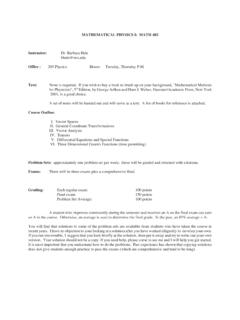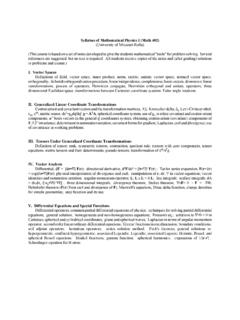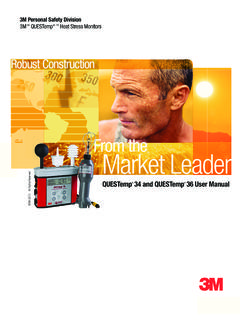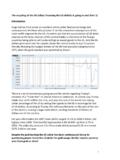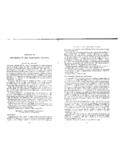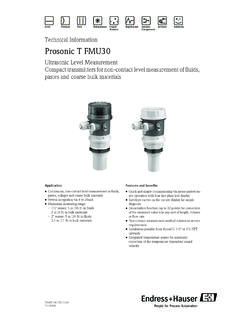Transcription of Fluid Flow Instrumentation - Missouri University of ...
1 Fluid Flow Instrumentation In the physical world, mechanical engineers are frequently required to monitor or control the flow of various fluids through pipes, ducts and assorted vessels. This Fluid can range from thick oils to light gasses. While some techniques work better with some groups of fluids, and less well with others, some are not at all suitable for some applications. In this primer on Fluid flow Instrumentation we will look at a wide variety of flow transducers and their application in the physical world. Fluid flow measurement Fluid flow measurement can encompass a wide variety of fluids and applications.
2 To meet this wide variety of applications the Instrumentation industry has, over many years, developed a wide variety of instruments. The earliest known uses for flow come as early as the first recorded history. The ancient Sumerian cities of UR and Kish, near the Tigris and Euphrates rivers (around 5000 ) used water flow measurement to manage the flow of water through the aqueducts feeding their cities. In this age the a simple obstruction was placed in the water flow, and by measuring the height of the water flowing over the top of the obstruction, these early engineers could determine how much water was flowing.
3 In 1450 the Italian art architect Battista Alberti invented the first mechanical anemometer. It consisted of a disk placed perpendicular to the wind, and the force of the wind caused it to rotate. The angle of inclination of the disk would then indicate the wind velocity. This was the first recorded instrument to measure wind speed. An English inventor, Robert Hooke reinvented this device in 1709, along with the Mayan Indians around that same period of time. Today we would look down our noses at these crude methods of flow measurement, but as you will see, these crude methods are still in use today.
4 Types of flow measurement devices Fluid flow devices fall into a number of device categories as well as Fluid classes. In general we can split the fluids into two classes; gasses and liquids. Within these two broad classes are a number of special classes that one should be careful of. Flammable liquids and gasses require special handling, as do those that are at temperature extremes (cold or hot). When selecting a transducer you should be cautious that the device you are selecting is compatible with the Fluid and conditions you hare working with. A few examples would be acids, food grade liquids, and DI water.
5 Surprisingly de-ionized water is an extremely harsh liquid that can cause serious headaches. Flow Measurement Page 1 Rev 9/xx/06 Mitchell Cottrell The physical measurement devices come in a number of classifications. While the following classifications do not match any industry standards, they serve to break the transducers down into some reasonably functional groups. These are: Obstruction flow meters Velocity flow meters Including Moving Member meters Positive Displacement meters Variable area meters Electronic meters We will spend some time at each category, looking at the particular devices that fall into that category.
6 Some of these devices will work with a wide array of fluids, while others have significant limitations. This tutorial should help you understand what these restrictions are and when to use or not use a particular meter. Obstruction flow meters Obstruction flow meters are the simples and oldest of the measurement classes. One of the first obstruction flow meters was used by the ancient Samarians. In order to measure the amount of water flowing through an aquaduct, they would place a board across the flow, and measure how high the water was when it flowed over the top of the board.
7 In this way they could easily calculate how much water was flowing in the duct. This was modified in later times to a device called a notch weir. Notch weir Notch weirs are classified by the shape of their notch; rectangular weirs; triangular, or V-notch, weirs; trapezoidal weirs; and parabolic weirs. The picture above shows a V-notch weir. The edge the water cascades over is called the crest and the overflowing water sheet is called the nappe. Today weirs are still used to determine flows from open water sources such as streams. A typical 90 V-notch will be beveled at 45 so the edge is less than thick, and the angle of the notch will be Flow Measurement Page 2 Rev 9/xx/06 Mitchell Cottrell precisely 90.
8 Water flow over the weir is calculated by the equation : Q= , where h1 = head on the weir in ft and Q = discharge over weir in ft3/s. It is easy to see that this is a simple measurement technique can be used on nearly any open flowing body of water. Its simply a matter of building a large enough weir plate. It is just as obvious that this technique wont work in an enclosed pipe, and it certainly wont work for gasses. The measurement of head is the height of the water above the lowest portion of the weir, and should be made at least four times that height, back from the weir.
9 Orifice plate Flow Measurement Page 3 Rev 9/xx/06 Mitchell Cottrell device that has been in use for measuhese plates are generally installed by trapping it e plate, he calculation for incompressible (liquid) flow is The equivalent of the notch weir in a tube would be an orifice plate. This flow device is created by inserting an obstructing plate, usually with a round hole in the middle, into the pipe and measuring the pressure on each side of the orifice. This is again a very simple ring both gas flow and liquid flow for decades. Tbetween two pipe flanges.
10 Pressure taps on each flange allow you to easily measure the pressure differential across the plate. This pressure differential, along with the dimensions of thare combined with certain Fluid properties to determine the flow through the pipe. Tdescribed by the incompressible Bernoulli equation,as long as the flow is sub-sonic ( < mach ). 222112 PVV = Given the following physical layout, you can modify this formula to take into account the e case nce, dimensional information rather than the velocity. Also the equation above assumes perfectly laminarflow, which is generally not thin the real world.
